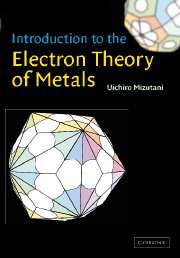Book contents
- Frontmatter
- Contents
- Preface
- 1 Introduction
- 2 Bonding styles and the free-electron model
- 3 Electrons in a metal at finite temperatures
- 4 Periodic lattice, and lattice vibrations in crystals
- 5 Conduction electrons in a periodic potential
- 6 Electronic structure of representative elements
- 7 Experimental techniques and principles of electronic structure-related phenomena
- 8 Electronic structure calculations
- 9 Electronic structure of alloys
- 10 Electron transport properties in periodic systems (I)
- 11 Electron transport properties in periodic systems (II)
- 12 Superconductivity
- 13 Magnetism, electronic structure and electron transport properties in magnetic metals
- 14 Electronic structure of strongly correlated electron systems
- 15 Electronic structure and electron transport properties of liquid metals, amorphous metals and quasicrystals
- Appendix 1 Values of selected physical constants
- Principal symbols (by chapter)
- Hints and answers
- References
- Materials index
- Subject index
9 - Electronic structure of alloys
Published online by Cambridge University Press: 20 November 2009
- Frontmatter
- Contents
- Preface
- 1 Introduction
- 2 Bonding styles and the free-electron model
- 3 Electrons in a metal at finite temperatures
- 4 Periodic lattice, and lattice vibrations in crystals
- 5 Conduction electrons in a periodic potential
- 6 Electronic structure of representative elements
- 7 Experimental techniques and principles of electronic structure-related phenomena
- 8 Electronic structure calculations
- 9 Electronic structure of alloys
- 10 Electron transport properties in periodic systems (I)
- 11 Electron transport properties in periodic systems (II)
- 12 Superconductivity
- 13 Magnetism, electronic structure and electron transport properties in magnetic metals
- 14 Electronic structure of strongly correlated electron systems
- 15 Electronic structure and electron transport properties of liquid metals, amorphous metals and quasicrystals
- Appendix 1 Values of selected physical constants
- Principal symbols (by chapter)
- Hints and answers
- References
- Materials index
- Subject index
Summary
Prologue
We have so far discussed the electronic structure of metals and semiconductors existing as elements in the periodic table and have assumed a crystal to be ideally perfect without containing any defects like impurities, vacancies, dislocations and grain boundaries. In reality, no metal is perfectly free from such defects, which certainly disturb the periodicity of the lattice and cause scattering of the Bloch electron. Foreign elements can be intentionally added to a given metal, resulting in the formation of an alloy. When the amount of the added element is dilute, the added atoms may be treated as impurities. But when its concentration exceeds several atomic %, the interaction among the added atoms is no longer neglected. In this chapter, we discuss first the effect of an impurity atom on the electronic structure of a host metal and then move on to discuss the electronic structure of concentrated alloys.
Impurity effect in a metal
Let us consider first a perfect metal crystal consisting of the atom A with the valency Z1. All atoms become positive ions with the valency +Z1 by releasing the outermost Z1 electrons per atom to form the valence band. As a result, conduction electrons carrying negative charges are uniformly distributed over any atomic site with equal probability densities and maintain charge neutrality with the array of ions with positive charges. Now we replace the atom A at a given lattice site by the atom B with valency Z2 (Z2>Z1). Effectively, a point charge equal to ΔZ=Z2-Z1 is formed at the atom B and the uniform charge distribution is disrupted.
- Type
- Chapter
- Information
- Introduction to the Electron Theory of Metals , pp. 224 - 248Publisher: Cambridge University PressPrint publication year: 2001

